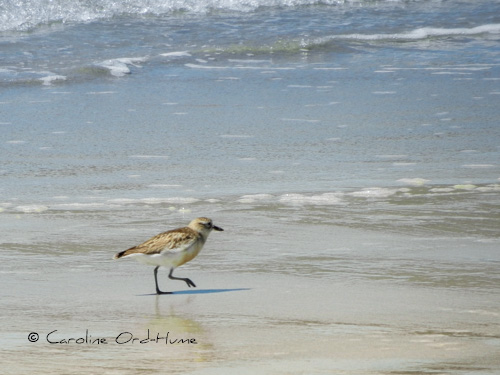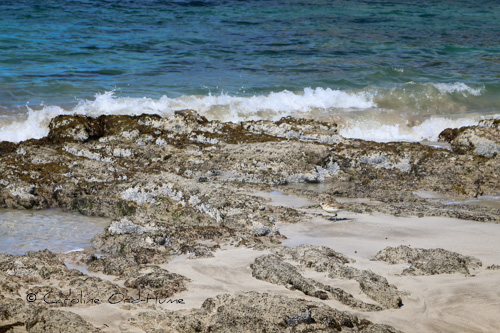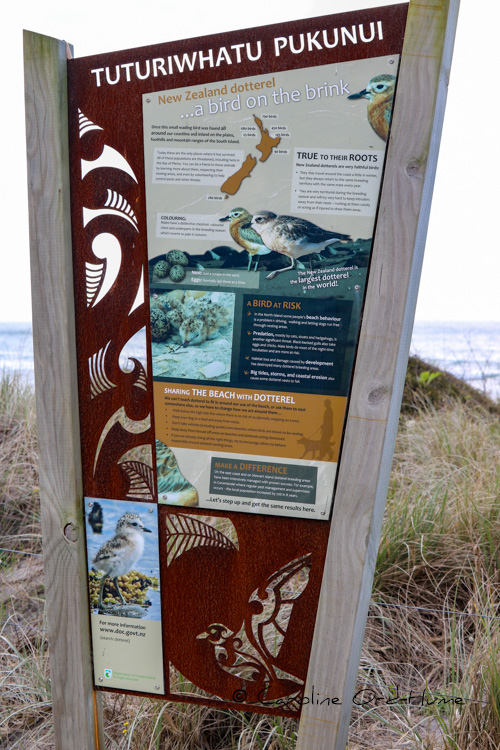New Zealand Dotterel / Tūturiwhatu-pukunui: A Precious Shoreline Guardian
The New Zealand Dotterel, Tūturiwhatu-pukunui, (Charadrius obscurus) is a small, charismatic bird that holds a special place in the hearts of Kiwis and other conservationists alike. This intriguing species, known for its unique habits, habitat, and conservation status, offers a fascinating glimpse into the world of New Zealand's coastal ecosystems.

New Zealand Dotterel / Tūturiwhatu-pukunui (Charadrius obscurus) on Cooks Beach, Coromandel Peninsula
Dotterel Species
The New Zealand Dotterel is a member of the Charadriidae family, which includes other shorebirds like plovers and sandpipers. Specifically, it belongs to the genus Charadrius, characterized by its small size, distinctive plumage, and long legs.
There are two recognised subspecies of the New Zealand Dotterel, each inhabiting different regions of the country. These subspecies are the North Island northern New Zealand Dotterel (Charadrius obscurus aquilonius), the South Island southern New Zealand Dotterel (Charadrius obscurus obscurus). The northern subspecies resides around the North Island coast, the southern subspecies is mostly restricted to Stewart Island now.
Conservation Status
Northern New Zealand Dotterel is At Risk and Recovering
Southern New Zealand Dotterel is Threatened and Nationally Critical
Name and Family
Name: New Zealand Dotterel - Scientific name: Charadrius obscurus - Family: Charadriidae
Other Names for New Zealand Dotterel
The New Zealand Dotterel goes by various names depending on its region and the subspecies in question. In addition to its scientific name, it is commonly referred to as Red-breasted Dotterel, Red-breasted Plover, and sometimes the New Zealand Plover.
The Maori people have their names for this bird, Tūturiwhatu, Tūturiwhatu-pukunui, rako. These names reflect the bird's significance and cultural ties within New Zealand.
You may interested in other NZ wildlife...
List of native New Zealand birds and other wildlife in New Zealand
Habitat and Distribution
The New Zealand Dotterel wading bird is predominantly a coastal dweller, favouring sandy or shell covered shorelines, estuaries, and salt marshes. Its range spans the North, South, and Stewart Islands of New Zealand, with each subspecies occupying its own geographic niche.
The northern New Zealand Dotterel is, as the name suggests, found primarily in the North Island, while the southern South Island Dotterel inhabits the South Island's southern coasts but only breeds on Stewart Island.
These wading birds are highly territorial, defending their chosen patches of shoreline with unwavering commitment. They are known to be particularly sensitive to disturbances in their habitat, making conservation efforts critical to their survival.

Spot the New Zealand Dotterel / Tūturiwhatu-pukunui on Hahei Beach, Coromandel Peninsula
Description and Identification
New Zealand Dotterels are small wader shorebirds, with an average length of 25 centimetres and weight of: 146 g (for the northern), 160 g (for the heavier southern). They possess distinctive plumage, characterized by a brownish-grey upper body with underparts being off-white in autumn-early winter, turning orange-red from May. Their beaks are black and their legs are long enough to aid foraging and wading activities.
Identifying the different subspecies can be challenging, as they share similar plumage and characteristics. However, experts often rely on geographic location, subtle variations in plumage, and the southern birds heavier weight to differentiate between them.
Diet of New Zealand Dotterel Birds
New Zealand Dotterels are opportunistic feeders, primarily preying on small invertebrates found by wading along the shoreline. Dotterel diet consists of a variety of coastal creatures, including insects, crustaceans such as Sand Hoppers (Talitrus saltator), molluscs, and small worms. To obtain their meals, they wade into shallow waters and use their slender bills to probe into the sand or mud for hidden prey. This foraging behaviour is particularly well-suited to their coastal habitat.
Survival and Conservation of Dotterel Birds in NZ
Despite their endearing qualities and the unique ecosystems they inhabit, New Zealand Dotterel birds face several challenges to their survival, making them a focal point of conservation efforts in New Zealand. Some of the primary threats they encounter include:
Dotterel Birds Habitat Loss:
The ongoing development of coastal areas for urbanisation, agriculture, and tourism has resulted in the destruction and fragmentation of the New Zealand Dotterel's habitat. Nesting sites, in particular, are vulnerable to disturbance and destruction.
Introduced Predators:
Introduced species, such as cats, dogs, rats, and stoats, pose a significant threat to New Zealand Dotterels. These predators often target the birds' eggs and chicks, decimating local populations.
Human Disturbance:
Human activities, including recreational beach use and dog walking, can disrupt nesting sites and disturb breeding Dotterels. As these birds are particularly sensitive to disturbance, even well-intentioned beach-goers can inadvertently impact their survival.
Potential Climate Change:
Changes in sea levels and weather patterns can alter the Dotterel's coastal habitat and impact their food sources. This, in turn, can affect their breeding success and overall survival.
Conservation Strategies
Conservation efforts are underway to protect the New Zealand Dotterel and its habitat. Some of the key strategies include:
Predator Control:
Conservation organisations and government agencies implement predator control programs to reduce the threat posed by introduced predators. This involves trapping, baiting, and monitoring to protect nesting sites and young Dotterels.
Dotterel Habitat Restoration:
Efforts are made to restore and protect critical habitat areas, including the establishment of predator-free islands and the creation of protected reserves along the coast.
Community Engagement:
Raising awareness among the public and engaging local communities is crucial for Dotterel conservation. Education and community involvement can help reduce human disturbance and garner support for protective measures. The erection of information board and signs helps educate beach goers and dog walkers.

New Zealand Dotterel / Tūturiwhatu-pukunui - DOC Conservation Information Board and Sign
Dotterel Research and Monitoring:
Ongoing research and monitoring programs provide valuable insights into Dotterel populations, behaviour, and breeding success. This information informs conservation strategies and helps measure their effectiveness.
The Future Survival of New Zealand Dotterels
The New Zealand Dotterel is a testament to the fragile balance between human development and the preservation of precious natural habitats. With concerted efforts from conservationists, government agencies, and the public, there is hope that these charming birds will continue to thrive along New Zealand's shores for generations to come. As guardians of the coastline, they remind us of the importance of safeguarding our unique and delicate ecosystems.